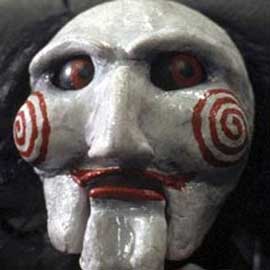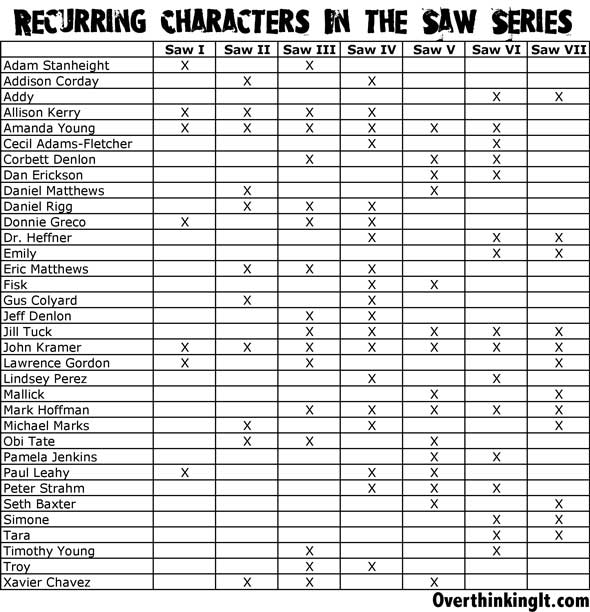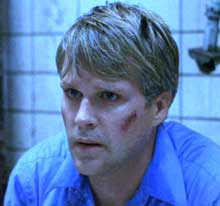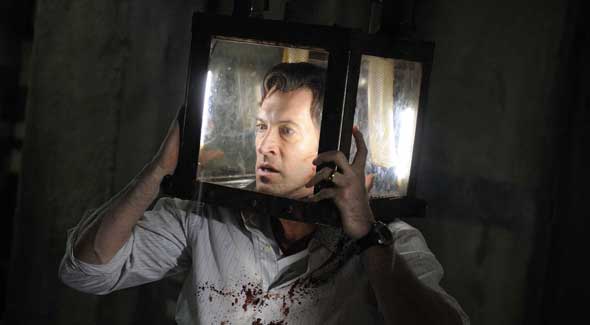
Fact: clowns make everything creepier.
Updated: I added a new section to the end of this article, after the release of Saw 3D.
To understand the Saw series, all you have to do is look at the production company’s logo. Before each film, the words “Twisted Pictures” are ensnared by coils of nasty-looking barbed wire. Then they are impaled by a metal spike. Then the metal spike is rotated, tightening the wire and gouging deep scars in the poor letters. In less than ten seconds, this animation encapsulates the series’s infamous modus operandi: horrible pain is inflicted with low-tech tools, and we’re forced to watch. Twisted.
But think about the other meaning of the word “twisted”: as in, “full of twists.” This is far and away the most plot-heavy, convoluted horror film series ever. It’s not an exaggeration to say you stand no chance of understanding the later films without having seen the earlier ones, preferably only days before. (I recently watched all six in less than two months, and I still found myself heading to the IMDB message boards to figure out what was going on.) Seemingly minor characters return in later films, suddenly thrust into the spotlight. We flash backwards and forwards, revisiting the events of past films from multiple angles. And through it all, there’s the killer’s teasing insistence that he’s building to SOMETHING; that each death is another piece in a master plan.
The people who know the Saw movies only from the advertisements assume their appeal is the twisted traps. But for the fans, it’s the twisted PLOTLINES that has us counting the days until Halloween.
[optin-monster-shortcode id=”ll7hbqdkyb3reqr1ue6g”]
[Note: Saw spoilers follow in great quantities. Since I’ve found the series enormously entertaining, I advise anyone who’s not fully up to speed to bookmark this page and come back when you’re Sawed up.)
If you’re a Saw virgin who ignored my warning and kept reading, first of all, don’t try that stuff with Jigsaw. It tends to end poorly. Secondly, you’re probably thinking, “C’mon Matt, they’ve pumped out a Saw sequel every Halloween for the past seven years. The only way you make movies that quickly is if you’re letting the interns write them for college credit. How tightly-plotted could these films possibly be?” Well, here are some examples:
- In Saw III, we see a character read a letter and burst into tears, shortly before flying into a homicidal rage. We don’t learn who wrote this letter until Saw IV. We don’t learn what it said until Saw VI.
- Saw III shows us the five minutes immediately after the end of Saw II. Saw IV shows us what happens immediately after THAT.
- Saw IV actually takes place during the events of Saw III, which is only revealed when a character from Saw IV literally walks into the final scene of Saw III, about two seconds after the previous film cut to black.
- Saw V picks up about thirty seconds after Saw III.
- You see the traps from Saw I being set up in flashback sequences during Saws III and V. You see the traps from Saw II being set up in flashback sequences during Saws III and V. You see the traps from Saw III being set up in flashback sequences during Saws V and VI. And I’m not talking about merely reusing footage – I’m saying that the latter movies recreated earlier sets and brought back actors who were chronologically deceased, to show us new information about things we’d already seen.
- After the credits of Saw VI, you see something that took place between the events of Saws II and III. It may be a critical clue to the denouement of Saw 3D, or a red herring.
- Did I mention that the main villain, Jigsaw, dies at the end of Saw III, and yet the events of all the subsequent movies are planned by him? And no, there’s nothing supernatural about it.
Not impressed yet? The following is a chart I’ve compiled from this Wikipedia page, showing all the characters that appear in more than one Saw film:

It’s the freaking Ring Cycle, but with more rusty industrial machinery.
There is no other horror film series that comes anywhere close to this kind of unified narrative. The Friday the 13th and Nightmare on Elm Street movies weren’t building off previous installments. The Final Destination movies, released concurrently with the Saws, were basically a series of remakes. The Scream movies had some continuity, but they certainly weren’t that complex, and there were only three (soon to be four, but that’ll be a reboot). Generally when it comes to slasher flicks, you keep the villain the same, but rotate in a new cast of pretty young lambs to the slaughter. The guys behind Saw didn’t get that memo.

Hello Jack. I want to play a game.
I think to understand the Saw movies, you have to consider another cultural phenomenon that came on the scene in 2004: a little show called Lost. The lesson everyone in Hollywood took from JJ Abrams’s runaway success was that audiences could be enthralled, not repelled, by huge mysteries that unfolded over years. The fans gathered online to obsess over theories and details, the more obscure the better. The Saw producers took this lesson to heart, and built the Saw sequels to be full of twists, complete with Lost-esque flashbacks and lots of loose ends. Want to know what’s in that mysterious wooden box that Jigsaw leaves for his ex-wife? Tune in next year.
At the end of Saw I, Dr. Gordon (Cary Elwes’ character) staggers away, dragging his bloody stump behind him, to bring police to the Bathroom of Doom in time to save Adam, whom he’s just shot (if you haven’t seen the movie, that sentence will seem strange). We know from the discovery of Adam’s rotted body in Saw II that help never arrived. However, we don’t learn what actually happened to Dr. Gordon after he left that room… until Saw VII (aka Saw 3D), when Cary Elwes makes his triumphant return. The series moves forward by looping backwards.
This is the kind of thing that drives Saw fans crazy, and sends them scrambling to their computers to exchange theories. On the House of Jigsaw message board, there are 67,000 posts about Saw V, 81,000 posts about Saw VI, and 66,000 posts about Saw 3D, which hasn’t even been released yet. And, taking another page from the Lost playback, the actors, writers, and directors of the series drop by the message boards frequently to answer questions and offer teasing nuggets of information.
Just FYI: there are no similar message boards about I Still Know What You Did Last Summer.

The Princess Bride was a long time ago.
Now, I don’t mean to give anyone the impression that the Saw series is a masterpiece of screenwriting craftsmanship. Clearly, when they made Saw I, the creators didn’t know that Jigsaw was working with the assistance of two, maybe even three accomplices. Saw II started out as a completely non-Saw-related story before being adapted into a quickie sequel. This kind of after-the-fact plotting leads to some inconsistencies that can’t be explained away. For instance, Jigsaw explains in Saw III that he despises murderers. But Amanda Young’s trap in Saw I requires her to murder. As part of Dr. Gordon’s trap, his wife and daughter are supposed to be killed if he fails. These make for dark “What would YOU do?” thrills, but there’s no way to square them with the Jigsaw we see in later movies. For instance, in Saw II, even though it seems like Detective Matthews’ son is in mortal danger, he turns out to be perfectly safe all along. Jigsaw might use the innocent as pawns, but he never makes them victims.
But even if every detail doesn’t add up, it’s worth celebrating how this series swings for the fences, when it doesn’t really have to. The studio would have totally accepted, and perhaps preferred, a series in which each installment stood on its own. Certainly, if you watch the trailers for these movies, they’re always marketed as, “It’s Halloween – come see some sadistic traps!” But the producers either believed that a complicated plot would hold an audience’s attention after the novelty of the traps had faded, or they just wanted to do it even though they didn’t think it was a smart business decision. Either way, I tip my creepy clown mask to them.
But the narrative complexity is only half the story. There’s also the surprising depth to the villain, John Kramer, aka Jigsaw. Horror movie bad guys usually fall into two categories: psycho killers (Michael Myers, Leatherface, the miner from My Bloody Valentine who kept throwing his pickax at me in 3D) and vengeful ghosts (Freddy, Jason, the creepy girl from The Ring who continues to haunt my dreams). Jigsaw was designed to be something new.

Now you’ve done it – I’m going to be on wikipedia all morning reading about these movies. I saw Saw II, which was enough for me to realize I cannot watch the rest of them, but I love reading the plots. I do remember thinking that Saw II was one of the best horror movies I’d seen. I just can’t handle the torture.
Please tell me this is the start of “Overthinking Saw Week”.
Having only seen the first Saw, Saw III and the first half of Saw IV, I have to say that this article has made me more interested in watching the series from beginning to end than any one of the film’s that I actually have seen. Well done, sir.
From a marketing standpoint, it’s actually kind of brilliant to have a series of films so intricately interwoven. It makes seeing any of the sequels independent of one another nearly incomprehensible, since they’re so story-dependent on one another, that the only real solution is to go out and spend money on Saw I-VI in order to understand what (may or may not have) happened in Saw 3D.
I feel like that’s either a very shrewd business decision, or the result of different teams of filmmakers trying to retcon each other into oblivion just to cover their own asses.
I couldn’t agree more. As a squeamish nerd I love horror but hate the whole wave of “sharp, rusty things being put into people” kind of horror. I watched Saw I because it sounded like that was “the good one”. Then number two because I may as well, I saw it projected onto a nightclub wall before being thrown out for laughing at the headbangers. Then the third because I may as well.
Anyway, as the series went on I watched it more and more for the jenga tower of continuity. I’ve yet to see number six so I’ve got that to do before number seven (killing Luke Danes in number five was a big no-no in my books).
I can’t help but feel that the goal of Jigsaw is doomed to failure, possibly intentionally. As the author mentions, survival and redemption are scarce, if at all possible. The initial plot of the first Saw movie has elements of revenge to it on Jigsaw’s part and perhaps from then was doomed to failure, the moment he wasn’t playing for the logical side of his ‘game’ but for personal reasons, much like Amanda had become more a killer than a ‘gamesmaster’ like her mentor. That led to her punishment, but an impure attitude to his own game possibly led to such a low success rate for Jigsaw’s grand design. Will anyone ever even manage to accomplish it if he gets what looks from the posters like a cult following, or will they fall prey to bloodlust and/or revenge plots?
For someone who couldn’t stand Wolf Creek because of the pointless nature of it, I’m very curious to see what they’ll do with the last film.
Great point. Jigsaw, of course, would claim that none of his games are about revenge. But in the first film, he chooses one victim who attempted suicide, and one victim who’s a junkie. Then he chooses Dr. Gordon, who… cheats on his wife. And HOW does Jigsaw know he’s been cheating on his wife? Because Jigsaw hired a private detective to follow him around. It does really seem like Jigsaw WANTED to put his doctor in a trap, and set out to find a reason for doing so.
I don’t think that Dr. Gordon set up Bobby’s trap, I think that Hoffmann did because Hoffmann knew about Bobby’s game but did not know about Gordon. I think the point of Dr. Gordon taking over was shown when Hoffmann killed Jill Tuck, showing that he let revenge cloud the point of the game. Jigsaw knew this would happen, so then he sent Dr. Gordon to take over for Hoffmann.
You know, I saw the first Saw movie, and I was very impressed by its execution, but almost everyone I knew said that the sequels did not live up to the first one. And I would later find out spoilers from other movies, such as Jigsaw dying at the end of the third film, and I would question how the films could still be any good or at all plausible after that happens.
After reading this article, I’m beginning to think that the Saw series is a lot like the Deathnote manga. Just as complex, but not nearly as supernatural.
Perhaps none of the sequels live up to the first, but after reading this, it seems that comparing the films side-by-side in that way is missing the point. From your writing, it seems like the experience of the entire series is the payoff. Which is really strange, cause the writing and directing team behind the films has changed a few times.
Now I have to watch all these films before Halloween…
There’s another series of movies where the studio logo provides a clue: Indiana Jones. The good ones, Raiders and Crusade, open with the Paramount logo, a mountain, match cutting to a real mountain. I.e., this is the real thing. The less good ones open with the Paramount mountain matching to something that resembles a mountain but isn’t. I.e., these are less than the real thing. In Temple it cuts to simply another image of a mountain (embossed on the silver gong in that Shanghai nightclub). In Crystal Skull they reach the nadir: the match cut is to a gopher mound—literally making mountains into molehills, as it were.
Regarding this whole idea of scaring people to death (literally) in order to make them appreciate life more: From a psychological point of view, it is total nonsense. It is well known that people suffer the worst traumatic experiences when it is other humans who do them harm (rape, assault, torture, acts of war, war crimes etc.). When we have to suffer from illness, accidents or natural disasters, traumatic experiences can indeed have a life-changing effect (if all turns out “well”). But if the suffering is man-made, it is much more likely to lead to feelings of hatred and revenge. The wounded soldier who comes home in high spirits because he now knows to value life more is not even a myth. It simply doesn’t work that way.
I know that Saw “is just a movie”, but in the article, Jigsaw’s “treatment plan” is described uncritically, as if it might actually work. As a psychologist, this bugs me a little bit and I wanted to set the facts straight. Besides this though, I liked the article (even though I don’t like the Saw movies).
Well, ACTUALLY… if you literally scare someone to death, they will be dead. And thus incapable of forming any new views on life.
But I agree with you. The main reason I’ve never watched the Saw movies is that, judging by what I’ve been told about them, the filmmakers endorse (at least tacitly) the belief that Jigsaw forces people to have a greater appreciation for life. That concept ruins my suspension of disbelief because i find it so jarring that it completely takes me out of the movie.
That said, I did very much enjoy the article, and the details of plot intricacies almost made me want to overcome my distaste and watch it. It also helped me to understand what my friends liked about these movies. So thanks for that!
… I guess I should have written “scaring people *with (their)* death …
Perhaps the final peice of the puzzle is that these people have been chosen to endure these ordeals specifically because they couldn’t – rather, they’re the types that would flip out afterwards, and continue on with Jigsaw’s legacy. Seems like that would be a rather twisted ending, all things considered.
Yes youre right, but in the film it is only the super crazy ones that feel vindicated. The final film shows that most of the victims are completely fucked from the experience.
My one problem with this is that Jigsaw consistently cheats with his traps. It happens literally in the opening moments of the first film; a character wakes up, drowning, and thrashes, sucking down the key that would unlock his manacles down the drain as he pulls the plug.
This is pretty consistent in the movies I’ve seen (I, II, and V), and it undercuts the series’ efforts to pass Jigsaw off as anything other than a self-righteous coward who wants to kill people he doesn’t like, but just can’t make himself take that final jump and actually deliberately act. He’s very passive-aggressive, when you think about it.
I’m going to need more specific examples. I’ve thought a lot about the key going down the drain in Saw 1, and I don’t think that’s cheating at all. The trap was for Adam to cut off his own foot to survive. Getting rid of the key is actually a NECESSARY part of this.
I think the movie focusing on the key in that opening shot, and having Jigsaw mention it again at the end, is needlessly confusing.
Don’t get me wrong – I’m open to the possibility that Jigsaw doesn’t play fair after all. I just think that’s not the best example.
I think Jigsaw left the key as a “thank you” for doing what Jigsaw asked of him (taking the pictures if my memory serves)… It’s not Jigsaw’s fault that Adam was clumsy. Besides he had the Saw AND (as I opined before Saw 3) Donnie Wahlberg’s character showed there WERE other ways to get out of that room. :)
I’m not even a big Saw fan but this is very interested, great article.
This article prompted me to start looking at the films wikipedia pages. While scouring over them I came across this little nugget in the intro section for Saw VI:
Following its cinematic release, the film failed to garner any award nominations from mainstream motion picture organizations for its production merits or lead acting.
True that has nothing to do with the films, but that is just way too funny not pass on.
I love the SAW series. I have seen all 7 in order, the last 3-4 in the theater opening weekend. They stimulate my mind the same way that Hannibal Lecter did in the Silence series of movies. Wish they would have done those up better as the SAW creators did. I love the plots, they blow my mind, stimulate every aspect of my intellect, and although I do cover my eyes throughout many parts of each of the last 6 movies, I love them, and truly hope they never stop making this series. I’ll pay my money for a ticket every single year. Jason Vorhes from 13th had 12 movies, and their plot sucked. SAW actually has a great story line, and they’ll successfully pulled of telling a unified story throughout 7 films, surely they can continue a few years more. DON’T STOP, PLEASE!
All Dr. Gordon did was the medical aspects of traps and the last request from John — watch over Jill (and “act immediately” if something were to happen). He wasn’t in with all the kidnappings, etc. Apparently he returned back to work at the hospital since that’s where Jill drops the package off.
Him putting the key behind Michael’s eye in Saw II and everything else had been predicated years ago on forums and YouTube (search Dr. Gordon theories). I can’t believe they actually used it in the film though. I was rather disappointed, mainly because the whole premise and plot of Saw 3D makes no logical sense (even for a Saw film) and fans practically wrote most of the Dr. Gordon scenes. There was no real plot twist or surprise. Just bleh. Saw VI is the real ending of the franchise. :P Nice read.
I’m not buying that all Dr. Gordon did was help Jigsaw out with the medical stuff. You know why? Because he was the one who set up the central game of Saw 3-D. Think about it – Hoffman didn’t kidnap Bobby and rig all those traps. He spent the whole movie trying to find Jill. When the police raid his lair, they find a bunch of monitors showing the POLICE station, not the game that’s currently going on. The Bobby game was ALL Dr. Gordon. I’m sure Jigsaw either designed part of it or all of it – there’s that flashback to when he and Bobby meet at the book signing. But Dr. Gordon was the one who rigged all those traps. (The fact that he KNEW how much weight the pectoral muscles can support is a giveaway.)
I didn’t mind seeing Dr. Gordon revealed as an apprentice, even if it wasn’t the craziest curve ball ever. It was satisfying – a big loose end tied up, the story come full circle. What disappointed me was how little we saw of Dr. Gordon’s relationship with Jigsaw. There’s a lot that’s vague there, and we really need Saw VIII to reveal how Dr. Gordon comes to assist Jigsaw, and what he does next.
Gordon’s two helpers were not identified. The film does not reveal WHY Gordon would help John. I mean it was just minutes before John dragged him off that Gordon was shouting he was going to KILL the man responsible for murdering his family (at the time he thought they had been killed). No mention of his family at all. They could have used another 5 minutes to explain things a bit more. I don’t understand why Lionsgate must need to condensed a complicated film to 90 minutes, especially when parts of Saw 8 was added to Saw 7. There was just more traps and gore than story. The real fans of the Saw films, watch them for the storyline, not guts. Though that is an added bonus.
Anyway, no I don’t believe Gordon did help with the games (we see Hoffman take out a box with Bobby’s game plans, so in the Saw universe that’s what happened, unless it’s proven otherwise in another film). Plus all of the Billy tapes for Bobby, Nina, Suzanne, Cale and Joyce were not by John, it was Hoffman. You can tell by the words Billy uses. One obvious clue was there was no wit added in the tapes and they were just to straightforward. I don’t believe there will be a Saw 8 — at least not in 2011. No closure for John and his work or the films (“all of my work as being leading to this”. To what?). He allowed Jill to die after promising a way out for her. So many more questions brought up than answered, just lazy storytelling. So we’ll have to go with this flat “final chapter”. It was a let down–it really was.
I’d forgotten about Hoffman looking at the photo of Bobby. That’s disappointing, because I really liked the idea that that was all Gordon. Gordon was at Bobby’s meeting. It’s a total coincidence that 5 minutes later HOFFMAN kidnaps him from the parking lot? While he’s busy trying to get Jill?
I’m a little less disappointed about how the movie didn’t explain Dr. Gordon’s relationship with Jigsaw, because these movies have ALWAYS left things unexplained for another movie. Yeah, right now there are no plans for Saw 8. Maybe it’s unlikely we’ll ever see it. But if the writers wanted to keep one thing mysterious, for fans to obsess over, that’s okay with me.
I GUESS it was a let down. I can’t really argue with you. But at the same time, I really enjoyed it – it didn’t feel like a letdown to me. Part of it was that this was the ONLY Saw film I saw in a theater. The rest I caught on DVD. I think being these with an opening weekend crowd made it more fun, and compensated for what probably is, in all fairness, a meh final chapter.
predicted*
Nice analysis.
One quick point….Dr. Gordon didn’t kill Gibson and the police it was Hoffman who set up the machine gun trap and deliberately led them to his lair for that purpose.
I think the other two with Dr Gordon at the end are his wife and son….I noticed one was shorter than the other.
Actually Raj, when I talked about Gordon killing all those cops, I was referring to the poison gas that gets the Swat team. To me, this seemed a little more bloodthirsty than the original Jigsaw. I remember in Saw 2, which is all about a Swat team closing in on Jigsaw. He breaks some shin bones, and he test Eric Matthews, but basically he’s got nothing against the cops.
I really like Jigsaw’s claim in Saw 2 that he never kills anyone, but it gets really hard to defend as the movies progress. Eventually, it’s just impossible to defend.
Well you are speaking like gordon did any of this but i don’t think so :
The big last test in saw 3d was clearly designed by hoffman (wich doesn’t give a fuck about killing since he kills everyone in the police station to get to jill)
Since the background off the place where the test is going is linked to hoffman and gibson, and also when gibson found the “lair” of hoffman where is the body of one of the racists, there are pictures and monitors of the last test, and obviously when you see the reaction of hoffman when he sees gordon he surely didn’t work with him.
Correction : yes mb the screens showed the police station, but i still believe that the pictures showed the test subjects.
However the position of the test is still heavily linked to hoffman ( i don’t exactly remember how but i think the junkie he killed to help gibson was from the place where the test is running or something like that)
However there could be two reasons for hoffman to deliberately give the position of the test while it was still running.
First Giving gordon up.
Or just to have the time to go and kill jill, since a trap was setted up to kill people entering the test i thibk it’s more of a genius plan from hoffman (and since hoffman really doesn’t give a damn about killing anymore i find this story way more credible than gordon turning mass murderer when all the footage we get of him in saw 3d is chirurgical interventions.)
This is great, I really enjoyed reading it. I was wondering if you could elaborate on the last paragraph? “By the way, I need to point something out. Eric Matthews was in the exact same situation Hoffman is in now, and he escaped. Moreover, we can be pretty sure that Hoffman KNOWS how he escaped. So Hoffman isn’t necessarily dead (but if I were a Saw writer, I’d wait a couple more movies before revealing that).”
Eric Matthews got his head squished didn’t he? I’m just a confused Saw fan ha ha.
Amanda locked Eric Matthews in the Bathroom of Doom without a saw. He was out five minutes later, by smashing his foot up. Hoffman would definitely know that, and there’s no reason he couldn’t attempt the same thing.
Hey there. When I was around 14 years old, I watched all seven films. I had PTSD from them. The logic didn’t add up to me. I am 19 today and still feel traumatized by them. Can we get a conversation going about anything related to this?
Also I’m a male.
Dang! Well done.